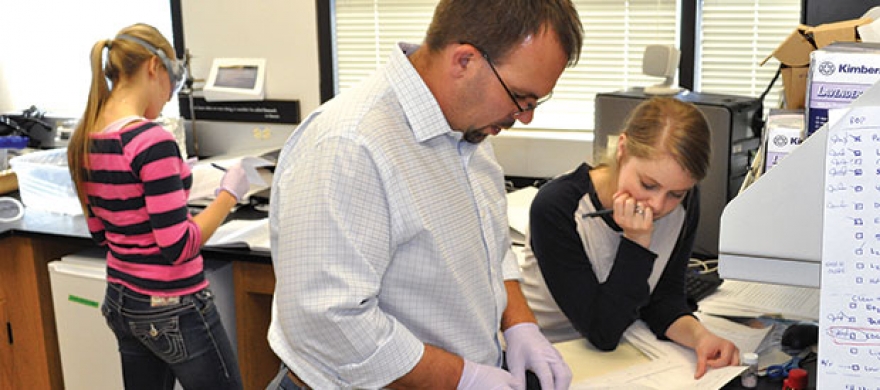Searching for Sustainability
Pepperdine problem solvers are working hard to revolutionize plastic.
The next time you pick up a plastic water bottle, know that as you are drinking, research is going on at Pepperdine to develop a less toxic material to contain your water. An undergraduate chemistry team is conducting high-level experiments in their quest to develop a more environmentally friendly plastic for everyday uses like product packaging, disposable cups, medical sutures, and your water bottle.
“This is a real world problem and we are doing something to try and solve it, or at
least pave the way for it to be solved,” says Angela Longo, a junior chemistry major.
With the mentorship of Pepperdine chemistry professor Joe Fritsch, the group’s research
involves experimenting with various metals to develop molecules that generate a biodegradable
material called polylactic acid (PLA), a polyester derived from renewable raw materials.
Most plastic today is petroleum-based; PLA is primarily corn-based, and is versatile
in that it can be made to degrade quickly or last for years.
The team of students, along with Fritsch, is conducting a number of tests involving
mixing compounds, developing new molecules, testing theories, and collecting and analyzing
data. It’s not easy work. It can take a long time to accomplish one goal, and the
outcome sometimes yields unexpected, but constructive results. But for Longo and her
co-researchers, Alexandria McCollum, Logan Schmitz, and Reile Slattery, the rewards
that come after the long exploratory process are worthwhile.
“You can theorize and plan your experiments to the moon and back, but there's always
a result that catches you off guard and it's always a lot of fun to work out what's
really going on,” says Schmitz, a senior chemistry major. Researcher Logan Schmitz in the Pepperdine chemistry research lab.
Researcher Logan Schmitz in the Pepperdine chemistry research lab.
What makes this research challenging is the fragility of the molecules, which are
killed by oxygen and water. Research must be conducted in a protective antechamber
or glove box, a sealed clear container in which users access the interior by inserting
their hands and arms into gloves attached to the chamber that allow access to the
inside. Fritsch explains that it can be vexing to create something that lasts for
only a short time.
“It’s a grinding discipline that you have to be willing to go back into every day,”
Fritsch says. “We’re engaged in discovery research. The universe doesn’t give out
its secrets without a fight.”
It took Fritsch and former student researcher Courtney Roberts (’11) three years to
learn how to make polylactic acid. On the day they discovered they had finally succeeded,
both cried happy tears.
“I will always remember that day as when I knew I would be a research scientist for
the rest of my life,” recalls Roberts, now a graduate student at the University of
North Carolina at Chapel Hill.
Nearly 20 students have come through the lab in the past eight years that Fritsch
has led this research. A large percentage of the students go on to graduate school,
while nearly half pursue medical school. Several graduates have been integral to the
team’s accomplishments and are spreading the knowledge they developed at Pepperdine. Professor Joe Fritsch and student Kim Gerling review data.
Professor Joe Fritsch and student Kim Gerling review data.
Roberts was the first to make PLA at Pepperdine and was awarded a prestigious National
Science Foundation Graduate Research Fellowship. Nomaan Rezayee (’12) is in chemistry
graduate program at the University of Michigan. He demonstrated that the speed of
making PLA can be adjusted faster or slower. Kim Gerling (’14) a U.S. Army officer
and medical school student at Uniformed Services University of Health Sciences, demonstrated
that second-generation catalysts with zinc were possible. They both completed honors
theses related to their respective research topics.
The accomplishments continue with the current team. Last year, in Pepperdine’s inaugural
Waves of Innovation program, Fritsch and his students won a nearly $70,000 grant to
expand their research to include additional metals and polymers.
“This project is a perfect example of how our faculty and students can contribute
to problem solving and to the scientific community,” says biology professor Lee Kats,
Waves of Innovation chair and vice provost for research and strategic initiatives.
“Joe views his students as co-creators of information and as colleagues, and together
they are working on solving a problem that has real societal implications.”
All four current students have presented their findings before thousands of chemists
and researchers at the annual American Chemical Society (ACS) national conference
and shared information with scientists worldwide. Their many accomplishments have
been published in multiple scholarly journals nationally and internationally. “We
are making progress in the lab faster than I can write,” Fritsch enthuses.
In addition to discovering new compounds and molecules, Slattery, a senior chemistry
major, says other benefits she has realized from working on the project include learning
to think critically and propel new ideas forward. McCollum has gained technical and
motor skills, a deeper understanding and appreciation for various aspects of chemistry,
and developed close friendships.
“The most incredible thing that I have learned over the course of my research is how
exciting it is to make a molecule that no one has made before,” says McCollum, a senior
who is pursing a double major in chemistry and English literature. “It really helps
one to appreciate the incredible number of discoveries that have not even been dreamed
of yet.”
